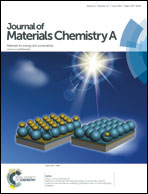Modular polymerized ionic liquid block copolymer membranes for CO2/N2 separation†
Abstract
The continuing discovery of broad classes of materials, such as ionic liquids, zeolites, metal–organic frameworks, and block copolymers, presents an enormous opportunity in developing materials for new applications. Polymerized ionic liquid block copolymers (PIL-BCPs) fall at the union of two already large sets of materials, and are an emerging class of materials useful in gas separation membranes, ion and electron conducting materials, and as mechanical actuators. A wide range of ionic liquid moieties can be used as pendant groups along the polymer backbone, potentially allowing for a wide variation in the resulting material properties; however in practice the range of ionic liquids explored is hindered by the need to optimize polymerization conditions for each new monomer. Here, we present a modular approach to PIL-BCP synthesis where a variety of olefin bearing cations are readily conjugated to polymers using thiol-Michael click chemistry. This approach allowed for the rapid development of a diverse material library including phase separated thin films, ion-gels, and liquid PIL-BCPs, with a reduced investment in synthetic time. Finally, we demonstrate that this approach identified PIL-BCPs with increased CO2 permeability relative to PILs, which could find use in carbon capture from flue gas.


 Please wait while we load your content...
Please wait while we load your content...